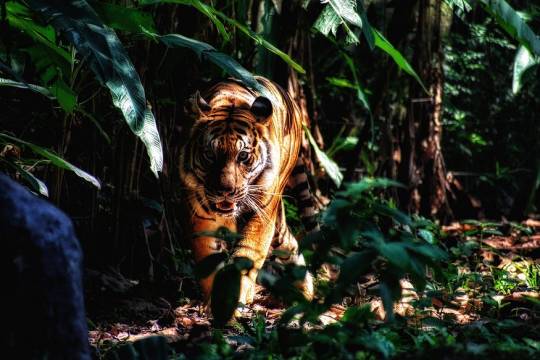Don't wanna be here? Send us removal request.
Text
The Most Endangered Animals in India
India is home to a rich diversity of wildlife, with over 500 species of mammals, 1,300 species of birds, 700 species of reptiles and 2,000 species of fish.
However, many of these animals are facing the threat of extinction due to habitat loss, poaching, climate change and human-wildlife conflict.
According to the International Union for Conservation of Nature (IUCN), India has 199 species of plants and animals that are critically endangered, meaning they have a very high risk of disappearing from the wild in the near future.
In this article, we will look at some of the most endangered animals in India and what is being done to protect them.
Bengal Tiger

The Bengal tiger is the national animal of India and one of the most iconic symbols of its wildlife. It is also the largest and most powerful of all the big cats, with an average weight of 200 kg and a length of 3 meters.
Bengal tigers are found in various habitats across India, from forests and grasslands to mangroves and wetlands. They are apex predators that feed on deer, wild boar, buffalo and other large animals.
However, the Bengal tiger is also one of the most endangered animals in India, with around 3,000 individuals left in the wild. The main threats to its survival are poaching for its skin and body parts, which are used in traditional medicine and as trophies, habitat loss due to deforestation and development, and human-tiger conflict, which occurs when tigers attack livestock or people.
To save the Bengal tiger from extinction, several conservation efforts have been launched, such as Project Tiger, which was started in 1973 by the Indian government to create tiger reserves and protect their habitats. Other initiatives include anti-poaching patrols, community awareness programs, wildlife corridors and translocation of tigers to new areas.
Asiatic Lion

The Asiatic lion is a subspecies of lion that is native to Asia and once roamed from Turkey to India.
However, due to hunting and habitat loss, it was reduced to a single population in the Gir Forest National Park in Gujarat, India. The Asiatic lion is smaller than its African cousin, with a larger tail tuft and a distinct belly fold.
It lives in groups called prides that consist of one or two males and several females and cubs. It feeds on deer, antelope, cattle and other prey.
The Asiatic lion is also an endangered animal in India, with only about 500–650 individuals left in the wild. The main threats to its survival are poaching for its bones and claws, which are used in traditional medicine and as ornaments, habitat loss due to agriculture and mining, and disease outbreaks such as the canine distemper virus.
To conserve the Asiatic lion from extinction, several conservation efforts have been implemented, such as Project Lion, which was launched in 1972 by the Indian government to protect the Gir Forest and its wildlife.
Other measures include vaccination campaigns, habitat restoration, compensation schemes for livestock losses and relocation of lions to new areas.
Snow Leopard

The snow leopard is a rare and elusive cat that lives in the high mountains of Central and South Asia. It has a thick fur coat that ranges from grey to yellowish-brown with black spots and rosettes.
It has a long tail that helps it balance on rocky terrain and a small head with large eyes and ears that help it detect prey. It feeds on wild sheep and goats, marmots, hares and other small animals.
The snow leopard is also an endangered animal in India, with only about 4,080–6,590 individuals left in the wild. The main threats to its survival are poaching for its fur and bones, which are used in traditional medicine and as clothing, habitat loss due to climate change and human encroachment, and human-snow leopard conflict, which occurs when snow leopards kill livestock or attack people.
To protect the snow leopard from extinction, several conservation efforts have been undertaken, such as Project Snow Leopard, which was initiated in 2009 by the Indian government to create snow leopard conservation areas and monitor their population.
Other actions include anti-poaching patrols, community education programs, livestock insurance schemes and transboundary cooperation with neighbouring countries.
Read More About The Wildlife
10 Funny-Looking Animals that You Should Know About
Behind the Numbers: Understanding the Tiger Census Process
Why Elephants May Not Exist in the Future?
India’s Remarkable Journey in Wildlife Protection
0 notes
Text

How Wildlife Censuses Help to Protect Endangered Species
Wildlife census is the process of estimating the population size and structure of wild animals in a given area. Wildlife census is important for various reasons, such as:
To monitor the status and trends of wildlife populations and their habitats.
To evaluate the effectiveness of conservation and management interventions.
To identify the threats and challenges faced by wildlife and their ecosystems.
To inform policy and decision-making for wildlife conservation and sustainable use.

Direct count method
This method involves counting all or some of the individuals of a species that are visible or audible in a sample area or along a transect. This method can be applied to species that are conspicuous, abundant, or have distinctive features or sounds.
For example, the vehicle transect or road count method is widely used in India to count large herbivores like deer, antelope, and elephants. However, this method has some limitations, such as:
It may not be feasible or accurate for species that are rare, elusive, nocturnal, or cryptic.
It may be affected by factors such as weather, visibility, observer bias, and animal behaviour.
It may require a large sample size and effort to achieve a reliable estimate.
Indirect count method
This method involves counting the signs or traces left by animals, such as tracks, scats, nests, burrows, or camera trap images, and using them to infer the population size and structure. This method can be applied to species that are difficult to detect directly but leave identifiable marks or evidence of their presence. For example, the pugmark method and camera trap method are widely used in India to count tigers. However, this method also has some limitations, such as:
It may require a high level of expertise and training to identify and interpret the signs correctly.
It may be influenced by factors such as sign availability, persistence, detectability, and sampling design.
It may require complex statistical models and assumptions to estimate the population parameters.
Miscellaneous count method
This method involves using other sources of information or techniques to estimate the population size and structure of animals. This may include methods such as:
Capture-recapture method: This method involves marking or tagging a sample of animals and recapturing them after a certain period of time to estimate the population size and survival rate .
Distance sampling method: This method involves measuring the distance of animals from a line or point transect and using it to estimate the population density and abundance .
Genetic analysis method: This method involves collecting DNA samples from animals or their signs and using them to estimate the population size, structure, and diversity.
These methods can provide more accurate and reliable estimates than direct or indirect count methods, but they may also require more resources, skills, and technical support.
Conclusion
Wildlife census is a vital tool for wildlife conservation and management. It helps to assess the status and trends of wildlife populations and their habitats, evaluate the impacts of conservation interventions, identify the threats and challenges faced by wildlife, and inform policy and decision-making for wildlife conservation and sustainable use.
There are various methods of conducting wildlife census, each with its own advantages and limitations. The choice of method depends on the objectives, resources, and characteristics of the target species and area.
Read More About the Census Process and Wildlife
Behind the Numbers: Understanding the Tiger Census Process
Why Elephants May Not Exist in the Future?
India’s Remarkable Journey in Wildlife Protection
0 notes
Text
Unveiling the Secret: How Birds are Saving Our Planet!
Birds are not only beautiful and fascinating creatures, but also vital for the health and balance of our ecosystems. They provide many benefits to humans and other living beings, such as pollinating plants, controlling pests, dispersing seeds, cleaning up carcasses, and fertilizing soils.

Birds Pollinate Plants

Some plants depend entirely on birds for pollination, such as many species of orchids, proteas, and aloes. Birds also pollinate crops that humans use for food or medicine, such as bananas, coffee, cocoa, and vanilla. Without birds, many of these plants would not be able to produce seeds or fruits, and the diversity and beauty of our landscapes would be diminished.
Birds Control Pests

They consume millions of tons of bugs every year, reducing the need for pesticides and saving farmers money and resources. For example, birds eat up to 98% of corn insect pests in some areas and reduce grasshopper populations by 20–26%.
Birds also prey on mice, rats, gophers, squirrels, and other rodents that can spread diseases or destroy crops and infrastructure. Some farmers even use falcons or owls to scare away or hunt down pest birds that eat their grapes or other fruits.
Birds Disperse Seeds

This way, they help plants colonize new areas, restore degraded ecosystems, and create diverse and resilient landscapes. Birds can also carry seeds over long distances, such as across oceans or mountains, introducing new plant species to isolated islands or remote areas.
Some plants have evolved seeds that are specially adapted to be dispersed by birds, such as those with hooks, barbs, or wings.
Birds Clean Up Carcasses

They also recycle nutrients back into the soil and reduce the amount of waste in the environment. Birds are so efficient at cleaning up carcasses that they can remove up to 95% of the biomass within a few hours.
Birds Fertilize Soils

They can improve the water-holding capacity and structure of soils, making them more suitable for agriculture or gardening. Bird droppings can also fertilize coral reefs by providing nutrients to the algae that live in symbiosis with the corals.
Some bird droppings are so valuable that they have been harvested for centuries as a source of fertilizer or even explosives.
Conclusion
Birds are useful for the environment in many ways that we often take for granted or overlook. They help plants reproduce and diversify; they keep pests and diseases under control; they disperse seeds and restore ecosystems; they clean up carcasses and recycle nutrients; they fertilize soils and coral reefs.
Birds are essential for the functioning of our planet’s life support systems and for our own well-being. Therefore, we should respect and protect them from threats such as habitat loss, climate change, pollution, hunting, and invasive species.
Further Readings on Birds
Attract Birds to Your Yard with These Proven Strategies!
The 10 Most Common Birds in India: A Birdwatcher’s Paradise
International Vulture Awareness Day 2023 — Save Vultures
Endangered Birds Need Your Help: How to Make a Difference for the Environment and Yourself
Discover the Top 5 Migratory Birds that Visit India Every Year and Why They Are Amazing
Why Do Birds Migrate: Secrets of Bird Migration
Discover the Amazing Birds Sanctuary in India
#india#nature#wildlife#animals#wild animals#birds#bird photography#birdwatching#bird art#owls#parrot#birbs
0 notes
Text
In the Footsteps of the Tiger: A Wildlife Safari in Ramnagar
If you are looking for an adventure in the wild, you might want to consider a wildlife safari in Ramnagar, Uttarakhand. Ramnagar is the gateway to the famous Jim Corbett National Park, which is home to a variety of flora and fauna, including the majestic Bengal tiger.
In this blog post, I will share my experience of visiting Ramnagar and going on a tiger sighting safari.
I booked my trip through a reputed travel agency that arranged everything from accommodation to transportation. I stayed at a comfortable resort near the park, which offered a serene and natural ambience. The resort had all the amenities I needed, such as Wi-Fi, hot water, and delicious food. The staff was friendly and helpful, and they gave me some useful tips on how to make the most of my safari.
The next morning, I woke up early and got ready for the safari. I joined a group of other tourists and boarded a jeep that took us to the park entrance. There, we met our guide, who briefed us on the rules and regulations of the park.
He also told us some interesting facts about the wildlife and the history of the park. He said that Jim Corbett National Park is one of the oldest and largest national parks in India, covering an area of over 500 square kilometres. It was established in 1936 as Hailey National Park and later renamed after Jim Corbett, a legendary hunter-turned-conservationist who played a key role in saving the tigers from extinction.
As we entered the park, I felt a surge of excitement and anticipation. I had always wanted to see a tiger in its natural habitat, and this was my chance. The guide told us that there are about 200 tigers in the park, but they are elusive and shy animals, so spotting them is not easy. He said that we had to be patient and quiet and follow his instructions. He also warned us not to get out of the jeep or feed or disturb the animals.
We drove through the dense forest, which was rich in biodiversity. I saw many different kinds of trees, plants, flowers, and birds. The guide pointed out some of the common species, such as sal, teak, mango, peepal, banyan, jacaranda, orchid, parrot, hornbill, kingfisher, eagle, and vulture. He also told us about some of the rare and endangered species that are found in the park, such as gharial, otter, pangolin, python, elephant, leopard, bear, deer, monkey, and wild boar.
But the highlight of the safari was undoubtedly the tiger sighting. After driving for about an hour, we reached a spot where the guide said there was a high chance of seeing a tiger. He asked us to keep our eyes peeled and our cameras ready. He also told us to stay calm and quiet if we saw one. We waited for about 15 minutes, scanning the surroundings for any sign of movement or sound. Then suddenly, I heard a low growl from behind a bush. I turned my head and saw a flash of orange and black stripes. It was a tiger!

We watched the tiger for about 10 minutes until it got up and walked away into the forest. We followed it for a while until it disappeared from our sight. The guide congratulated us on our lucky sighting and said that we should consider ourselves fortunate to have witnessed such a rare and beautiful creature. He said that tigers are facing many threats from poaching, habitat loss, human-wildlife conflict, and climate change. He urged us to support conservation efforts and spread awareness about the importance of protecting tigers and their environment.
We continued our safari for another hour or so before returning to our resort. I was thrilled with my experience and felt like I had fulfilled one of my dreams. I thanked the guide and the driver for their service and tipped them generously. I also thanked the travel agency for arranging such an amazing trip for me.
I highly recommend visiting Ramnagar and going on a wildlife safari if you are looking for an unforgettable adventure in nature. You will not only enjoy the scenic beauty and diversity of Jim Corbett National Park but also get a chance to see one of the most majestic animals on earth: the Bengal tiger.
Further Reading on Tigers
Guru Ghasidas National Park: 54th Tiger Reserve of India
Behind the Numbers: Understanding the Tiger Census Process
Dholpur-Karauli: 55th Tiger Reserve in India
The Rise of the Tigers: India’s Remarkable Journey in Wildlife Protection
0 notes
Text
Tiger Reserves: More Than Just a Sanctuary
Tigers are one of the most majestic and endangered animals in the world. They are the largest and most powerful of the big cats, and they play a vital role in maintaining the balance of nature.
However, due to habitat loss, poaching, and human-wildlife conflict, their numbers have declined drastically in the last century. According to the World Wildlife Fund (WWF), there are only about 3,900 wild tigers left in the world, and they occupy less than 6% of their historical range.

That is why tiger reserves are so important for wildlife conservation. Tiger reserves are protected areas that are dedicated to the conservation of tigers and their prey, as well as other biodiversity.
They provide a safe haven for tigers to breed, hunt, and roam freely, without the threat of human interference. They also benefit other species that share the same habitat, such as elephants, rhinos, leopards, deer, monkeys, birds, and reptiles. By protecting tigers, we are protecting the entire ecosystem that they depend on.
Tiger reserves also have social and economic benefits for humans. They help preserve the natural resources that local communities rely on, such as water, soil, and forest products.
They also provide opportunities for ecotourism, education, and research, which can generate income and employment for the people living near them. Moreover, they contribute to the global efforts to combat climate change, by storing carbon and reducing greenhouse gas emissions.
Therefore, tiger reserves are essential for wildlife conservation and human well-being. They are not only a symbol of pride and heritage for the countries that host them, but also a legacy for future generations. By supporting tiger reserves, we are not only saving tigers but also saving ourselves.
Further Reading on Tigers
Guru Ghasidas National Park: 54th Tiger Reserve of India
Behind the Numbers: Understanding the Tiger Census Process
Dholpur-Karauli: 55th Tiger Reserve in India
The Rise of the Tigers: India’s Remarkable Journey in Wildlife Protection
1 note
·
View note
Text
10 Funny-Looking Animals that You Should Know About
Have you ever wondered what are some of the most funny-looking animals on Earth? There are millions of different species of animals, and some of them have very unusual appearances that can make us laugh or marvel at nature’s creativity. In this blog post, we will introduce you to 10 of these weird and wonderful creatures, and tell you some interesting facts about them.

1. Red-lipped Batfish
2. Quokka
3. Irrawaddy Dolphin
4. The Blue Parrotfish
5. Atretochoana
6. Shoebill
7. Blob Fish
8. Aye-aye
9. Star-nosed Mole
10. Tarsier
#india#nature#wildlife#animals#wild animals#dolphin#aye aye#tarsier studios#star nosed mole#blob fish#showbill#han quokka#red-lipped batfish#batfish
2 notes
·
View notes
Text
Learn How to Help Endangered Birds and the Environment
Birds are among the most diverse and beautiful creatures on Earth. They play vital roles in ecosystems, pollinating plants, dispersing seeds, controlling pests, and providing food and shelter for other animals.

Red-headed-vulture | credit: wallpaperflare.com
Causes and consequences of bird extinction
Bird extinction is primarily caused by the loss of habitat due to human activities such as agriculture, logging, mining, and urban development. Additionally, other threats include hunting, pollution, invasive species, and climate change.
IUCN Red List of Threatened Species
The IUCN Red List is a comprehensive database of species that are at risk of extinction.
According to the International Union for Conservation of Nature (IUCN) 182 species of Indian birds are in the categories of Critically Endangered, Endangered, Vulnerable, and Near Threatened. These species are threatened with global extinction, and trade in these species is internationally banned. Many of these species are endemic to the Indian Subcontinent, which has special relevance for the conservation of birds in India.
Endangered Birds in India
Some of the most endangered birds in India are listed below. The survival of these birds is at risk as their habitats are being destroyed, they are being hunted, and other human activities are threatening their existence.
Indian Vulture
Himalayan Quail
Siberian Crane
Great Indian Bustard
Red-headed Vulture
- Original Article Here - Endangered Birds Need Your Help: How to Make a Difference for the Environment and Yourself
0 notes
Text
Top 10 National Parks You Must Visit in India
A National Park is a designated area created by the government to safeguard the natural environment, wildlife, and biodiversity. These protected areas fall under the Wildlife Protection Act of 1972, prohibiting illegal hunting, poaching, and grazing.
India has spectacular 106 national parks, each offering a unique and breathtaking experience for nature lovers. For those seeking the ultimate adventure, we have curated a list of the top 10 national parks that are truly worth visiting at least once in your lifetime.
These exceptional destinations will leave you in awe with their stunning landscapes, diverse wildlife, and unforgettable experiences.
0 notes
Text
Behind the Numbers: Understanding the Tiger Census Process
Why Wildlife Census is Important?
Conducting a wildlife census is an essential measure to get valuable insights into various factors such as but not limited to current status, population trends, distribution, impact of conservation efforts, climate change, and disease outbreaks.
Similar to the human census, the wildlife census is also conducted at regular intervals and helps us to take necessary steps to protect the species from extinction.
Wildlife Census Methods
The census can be done direct or indirect method. In the direct methods, the individual animals are seen and counted, whereas in the indirect methods, evidence left by the animals such as footprints, poop, etc., are used to estimate the population.
There are other methods such as water hole census, camera traps, satellite tracking, etc., which are used to estimate the population.
Direct Methods
In the direct methods, either all the animals are counted or statistically sampled. In statistical sampling, a random sampling method is used to estimate the population and based on the sample size, the population is calculated.
Indirect Methods
The purpose of indirect methods is to estimate the population based on the evidence left by the animals. The evidence can be footprints, poop, nests, etc. The indirect methods are used when the direct methods are not feasible or too expensive.
Other Methods
Apart from the direct and indirect methods, there are other methods such as water hole census, camera traps, satellite tracking etc. which are used to estimate the population.
Water Hole Census
In the water hole census, the animals are counted by the number of animals visiting the water hole, the assumption being that all the animals visit the water hole at least once a day in summer. It is a simple and effective method to estimate the population of animals.
Raj, D. (n.d.).Retrieved August 29, 2023, from Behind the Numbers: Understanding the Tiger Census Process. Walk In The Wild
0 notes